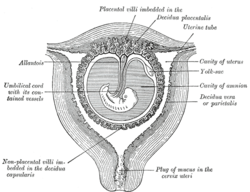Allantois
| Allantois | |
|---|---|

Diagram illustrating early formation of allantois and differentiation of body-stalk.
|
|

Sectional plan of the gravid uterus in the third and fourth month.
|
|
| Details | |
| Days | 16 |
| Precursor | yolk sac |
| Gives rise to | Umbilical cord |
| Identifiers | |
| Latin | Aallantois |
| MeSH | A10.615.284.147 |
| Code | TE E6.0.1.2.0.0.2 |
|
Anatomical terminology
[]
|
|
Allantois (/əˈlæntɔɪs/; plural allantoides or allantoises) is a sac-like structure that forms part of a developing amniote's conceptus (which consists of all embryonic and extra-embryonic tissues). It helps the embryo exchange gases and handle liquid waste.
The allantois, along with the amnion and chorion (other embryonic membranes), identify humans, and other mammals, as amniotes. Other amniotes include reptiles, dinosaurs, and birds. Of the vertebrates, only Ichthyopsidas (fish and amphibians) lack this structure.
This sac-like structure is primarily involved in nutrition and excretion, and is webbed with blood vessels. The function of the allantois is to collect liquid waste from the embryo, as well as to exchange gases used by the embryo.
The structure first evolved in reptiles and birds as a reservoir for nitrogenous waste, and also as a means for oxygenation of the embryo. Oxygen is absorbed by the allantois through the egg shell.
In most marsupials, the allantois is avascular, having no blood vessels, but still serves the purpose of storing nitrogenous (NH3) waste. Also, most marsupial allantoises do not fuse with the chorion. An exception is the allantois of the bandicoot, which has a vasculature, and fuses with the chorion.
...
Wikipedia
